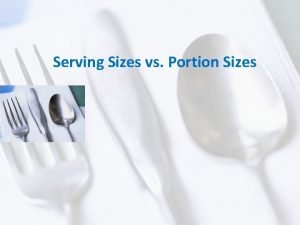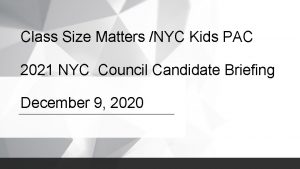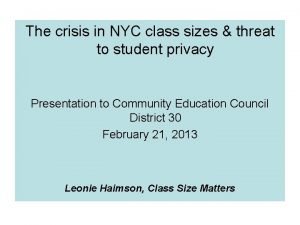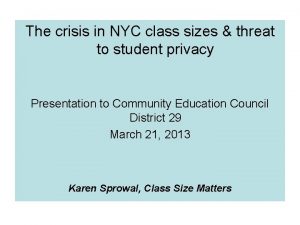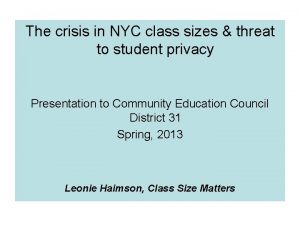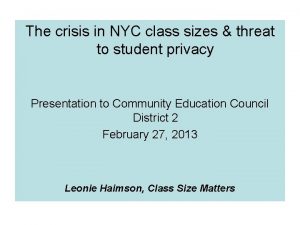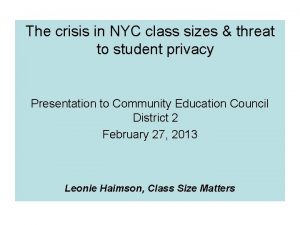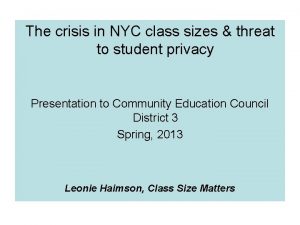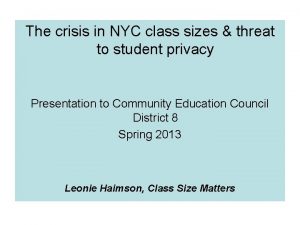The trend in NYC class sizes updated with













- Slides: 13

The trend in NYC class sizes updated with Nov. 2016 data and long-term trends Leonie Haimson Class Size Matters June 2017 www. classsizematters. org info@classsizematters. org

A note on data sources: DOE class size reports • All class size data is posted on DOE website from 2006 -2017 at http: //schools. nyc. gov/About. Us/schools/data/classsize. htm • We use DOE November reports for each year based on the October 30 register, except for 2006 and 2007 for which the November report no longer available. • The November reports are a more accurate picture of what students experience for the first few months of school, because many students have dropped out by January, especially in high school. • In general we believe the high school data is unreliable, because the faulty DOE reporting process causes many high schools to falsely report ICT (inclusion) classes or classes with ELL students as two separate classes. • These class size averages include data for general education classes, ICT (inclusion classes) and gifted classes, but not selfcontained special education classes capped at smaller sizes by state law. • For years before 2006 -7 when the DOE started publicly reporting class size, we employ data from the NYC Independent Budget Office which received it directly from DOE.

In Nov. 2016, class sizes changed relatively little from the previous year, according to DOE, ranging from a decrease of. 5 student per class in Kindergarten to an increase of. 1 student per class in grade 8 . Source: DOE Nov. 2016 class size summary posted at http: //tinyurl. com/zpjguya




Class sizes in K-3 are larger than they were in 1999 -2000 LT trend class size K-3 1998 -2016 24. 9 23. 2 24. 6 24. 2 22. 9 21. 7 21. 6 21. 4 21. 3 21. 1 21. 0 20. 9 22. 1 19 98 /9 9 19 99 /0 0 20 00 /0 1 20 01 /0 2 20 02 /0 3 20 03 /0 4 20 04 /0 5 20 05 /0 6 20 06 /0 7 20 07 /0 8 20 08 /0 9 20 09 /1 0 20 10 /1 1 20 11 /1 2 20 12 /1 3 20 13 20 /14 14 /2 01 5 20 15 /1 6 20 16 /1 7 22. 4 22. 1 24. 5 24. 9 24. 7 Data sources: Independent Budget Office & NYC DOE

Class sizes in grades 4 -8 are larger than in 2004 -5 LT trend class size grades 4 -8 Data sources: Independent Budget Office & NYC DOE





Queens & Staten Island have largest class sizes on average (Nov. 2016 DOE data)
 Men's shirt sizes are determined by their neck sizes
Men's shirt sizes are determined by their neck sizes The symbol tsfa in alu operations include
The symbol tsfa in alu operations include Guidelines on rpms 2021
Guidelines on rpms 2021 Contoh soal dan jawaban trend linier
Contoh soal dan jawaban trend linier Perbedaan trend linier dan trend non linier
Perbedaan trend linier dan trend non linier Hình ảnh bộ gõ cơ thể búng tay
Hình ảnh bộ gõ cơ thể búng tay Ng-html
Ng-html Bổ thể
Bổ thể Tỉ lệ cơ thể trẻ em
Tỉ lệ cơ thể trẻ em Gấu đi như thế nào
Gấu đi như thế nào Thang điểm glasgow
Thang điểm glasgow Hát lên người ơi alleluia
Hát lên người ơi alleluia Môn thể thao bắt đầu bằng chữ đua
Môn thể thao bắt đầu bằng chữ đua Thế nào là hệ số cao nhất
Thế nào là hệ số cao nhất















